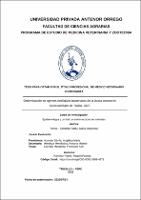Mostrar el registro sencillo del ítem
Determinación de agentes etiológicos bacterianos de la úlcera corneal en Canis familiaris de Trujillo, 2020
| dc.contributor.advisor | Ramírez Reyes, Raquel Patricia | |
| dc.contributor.author | Torres - Calderón Sattui, María Alejandra | |
| dc.creator | Torres - Calderón Sattui, María Alejandra | |
| dc.date.accessioned | 2023-10-02T15:10:09Z | |
| dc.date.available | 2023-10-02T15:10:09Z | |
| dc.date.issued | 2023 | |
| dc.identifier.uri | https://hdl.handle.net/20.500.12759/11238 | |
| dc.description.abstract | En el presente trabajo de investigación con el objetivo de determinar los agentes etiológicos bacterianos implicados en la infección de la úlcera corneal en caninos de Trujillo, se tomaron 27 perros durante el periodo comprendido entre noviembre – marzo 2020, bajo los criterios de inclusión: cualquier rango de edad, raza, sexo, confirmados con úlcera corneal mediante la prueba de fluoresceína y con antecedentes de la patología. Fueron examinados y muestreados para determinar el agente bacteriano mediante tinción Gram y crecimiento en cultivos microbiológicos, además se evaluaron las variables sexo, edad, raza, convivencia con otros animales, gravedad, ojo afectado, signos clínicos, y alteraciones que influencian la presentación de esta patología. Se obtuvieron 44 aislamientos en total, siendo Staphylococcus sp. (38%), la especie bacteriana aislada con mayor frecuencia. Los perros adultos (51.7%), de raza (65%), machos (62%), que convivían con otros animales (72%), con lesión unilateral (44%), triquiasis (63%), blefaritis (60%), conjuntivitis (53%) y gravedad profunda (47%) fueron los hallazgos más frecuentes. La prueba de Chi cuadrado determinó asociación de la gravedad superficial con signos clínicos de epifora (p=0.009), hipopión (p=0.000), edema (p=0.000), dolor (p=0.026) y uveítis (p=0.045); y, la gravedad profunda con epifora (p=0.035), hipopión (p=0.001), fotofobia (p=0.031), edema (p=0.002) y uveítis (p=0.045). Se concluye que Staphylococcus sp. es el agente bacteriano más frecuente de la úlcera corneal, manifestada en canes adultos, de raza, machos, que convivían con otros animales, con alteraciones como triquiasis, conjuntivitis y blefaritis. Así mismo, asociación significativa entre el signo clínico de dolor y la gravedad superficial, y fotofobia para la gravedad profunda. Siendo epifora, hipopión, edema, y uveitis, asociados para ambas presentaciones de gravedad. | es_PE |
| dc.description.abstract | In the present research work with the objective of determining the bacterial etiological agents involved in corneal ulcer infection in canines from Trujillo, 27 dogs were taken during the period between November - February 2020, under the inclusion criteria: any range of age, race, sex, confirmed with corneal ulcer by means of the fluorescein test and with a history of the pathology. They were examined and sampled to determine the bacterial agent by Gram staining and growth in microbiological cultures, in addition the variables sex, age, breed, living with other animals, severity, affected eye, clinical signs, and alterations that influence the presentation of this disease were evaluated. pathology. A total of 44 isolates were obtained, with Staphylococcus sp. (38%), the most frequently isolated bacterial species. Adult dogs (51.7%), purebred (65%), males (62%), living with other animals (72%), with unilateral lesion (44%), trichiasis (63%), blepharitis (60 %), conjunctivitis (53%) and deep ulcer (47%) were the most frequent findings. The Chi-square test determined the association of superficial severity with clinical signs of epiphora (p=0.009), hypopyon (p=0.000), edema (p=0.000), pain (p=0.026) and uveitis (p=0.045); and deep severity with epiphora (p=0.035), hypopyon (p=0.001), photophobia (p=0.031), edema (p=0.002) and uveitis (p=0.045). It is concluded that Staphylococcus sp. It is the most frequent bacterial agent of corneal ulcer, manifested in adult, purebred, male dogs that lived with other animals, with alterations such as trichiasis, conjunctivitis, and blepharitis. Likewise, significant association between the clinical sign of pain and superficial severity, and photophobia for deep severity. Being epiphora, hypopyon, edema, and uveitis, associated for both presentations of severity. | en_US |
| dc.description.uri | Tesis | es_PE |
| dc.format | application/pdf | es_PE |
| dc.language.iso | spa | es_PE |
| dc.publisher | Universidad Privada Antenor Orrego | es_PE |
| dc.relation.ispartofseries | T_MED.VETE_176 | |
| dc.rights | info:eu-repo/semantics/embargoedAccess | es_PE |
| dc.rights.uri | https://creativecommons.org/licenses/by/4.0/ | es_PE |
| dc.source | Universidad Privada Antenor Orrego | es_PE |
| dc.source | Repositorio institucional - UPAO | es_PE |
| dc.subject | Úlcera | es_PE |
| dc.subject | Caninos | es_PE |
| dc.title | Determinación de agentes etiológicos bacterianos de la úlcera corneal en Canis familiaris de Trujillo, 2020 | es_PE |
| dc.type | info:eu-repo/semantics/bachelorThesis | es_PE |
| thesis.degree.grantor | Universidad Privada Antenor Orrego. Facultad de Ciencias Agrarias | es_PE |
| thesis.degree.name | Medico Veterinario Zootecnista | es_PE |
| thesis.degree.discipline | Medicina Veterinaria y Zootecnia | es_PE |
| dc.subject.ocde | http://purl.org/pe-repo/ocde/ford#4.03.00 | es_PE |
| renati.advisor.orcid | https://orcid.org/0000-0003-3988-4571 | es_PE |
| renati.author.dni | 74383124 | |
| renati.advisor.dni | 43025828 | |
| renati.type | http://purl.org/pe-repo/renati/type#tesis | es_PE |
| renati.level | http://purl.org/pe-repo/renati/level#tituloProfesional | es_PE |
| renati.discipline | 841056 | es_PE |
| renati.juror | Huamán Dávila, Angélica María | |
| renati.juror | Mendoza Mendocilla, Roxana Marisol | |
| renati.juror | Carvajal Mestanza, Francisco Abel | |
| dc.publisher.country | PE | es_PE |
| dc.date.embargoEnd | 2028-10-02 |
Ficheros en el ítem
Este ítem aparece en la(s) siguiente(s) colección(es)
-
Veterinaria y Zootecnia [163]




